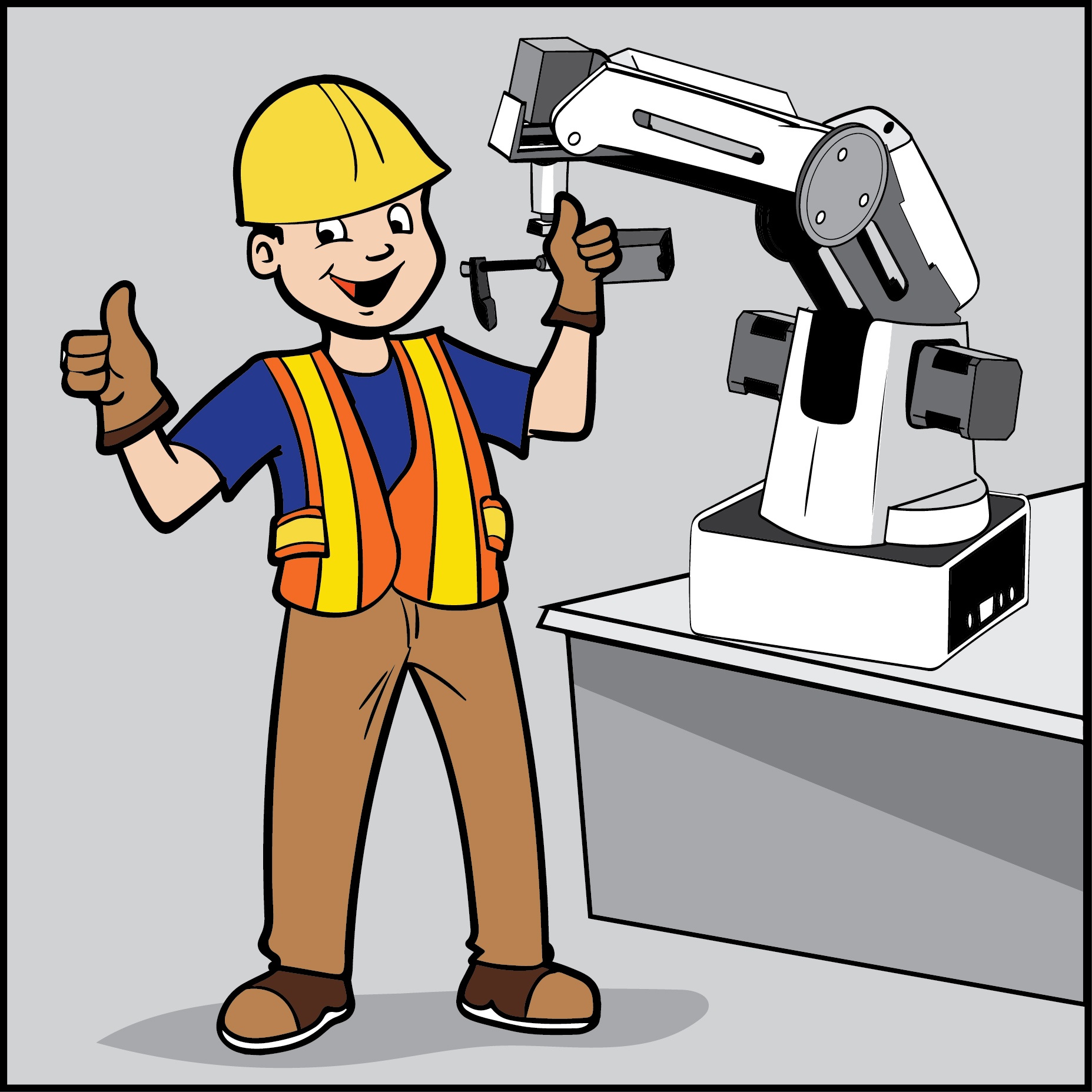Lesson Modules
Teaching Tips:
Observe Module Overview
- Teacher will grab student’s attention by asking them to look at the video introducing them to safety with robot automation.
- After pictures and lesson, students will work on planning and designing their challenge safety project
Lesson Overview
- Ensure the Dobot firmware and software is updated to the latest version. This will reduce troubleshooting.
- This lesson can be done individually or in groups. Depending on the size of class or number of robots. If several students per robot, you might want to assign them separate responsibilities for full engagement.
- This lesson can take between 1 to 2 class periods depending on the coding knowledge of students with Blockly, Script, Dobot in general, and the design of their project.
- This lesson and skills are considered the minimum. This project requires troubleshooting hardware, software, and their overall project design to get it working properly as stated in the challenge.
- The lesson recommended display boards, but you may use many other materials to create envelope workspace.
- The code included is just a sample code and project lesson taught in the Dobot IT Lessons from Robotlab. You may use this automated project to have students save time on their project and have them focus on safety design of the work envelope. A video is included showing the automated project.
Materials Needed:
Here is a lesson plan for your records.
Print this pick and place handout students will need during the Prototype module.
Use this code solution as a reference for grading.
Here is a detailed explanation of the code solution. It is useful to help students who are stuck in the prototyping process.
Optional Materials:
Print these Key terms if you'd like to use them as a reference.
Have you heard of these organizations before?


Teaching Tips:
Explore Module Overview
- Students discover the overall importance of following guidelines for robot automation in the workplace
- Students will be able to explain the need for a robot work envelope and explain how the different safety circuits work.
- Students will practice designing a safe operating work envelope, troubleshooting hardware, and software to work properly
- Students learn problem solving using code, sensors, and robots
- Students will learn to design safety, test the code and trouble shoot
- The teacher will check for understanding by asking questions
Questions
- What is OSHA?
- What other improvements or changes can I make?
- How can I modify the code?
Higher order thinking question
- What other safety system design can I create?
Key Terms
- OSHA - With the Occupational Safety and Health Act of 1970, Congress created the Occupational Safety and Health Administration (OSHA) to assure safe and healthful working conditions for working men and women by setting and enforcing standards and by providing training, outreach, education and assistance.
- ANSI - American National Standards Institute (ANSI) is a private non-profit organization that oversees the development of voluntary consensus standards for products, services, processes, systems, and personnel in the United States.
- NIOSH – The National Institute for Occupational Safety and Health (NIOSH) is responsible for conducting research and making recommendations for the prevention of work-related injury and illness.
- operating work envelope – The work envelope is the range of movement of a robot. It is the shape created when a manipulator reaches forward, backward, up and down. These distances are determined by the length of a robot's arm and the design of its axes.
- end-effector - An end-effector is an accessory tool specifically designed for attachment to a robot wrist to enable the robot to perform its intended task.
- Teach pendant – A device needed to control an industrial robot remotely. The device allows its controller to work with robots without the need for tethering to a fixed terminal.
Teaching Tips:
Prototype Module Overview
Each group or individual is to program Dobot with the following guidelines:
- Dobot project must function properly doing its normal day to day operations, but STOP when human detected as shown on video
At your discretion, to save time, we have included code for a already designed Dobot task. Please look at teacher tips for more info.
How can you keep human workers safe while working alongside the Dobot?
Your group is to plan, design, and build a DOBOT operating work envelope.
Identify risks
- Measure Dobot’s reach to see where it could hit someone
- Ensure people are protected from moving parts that may pinch
Make a safety plan
- Example: create a dress code so loose clothing doesn’t catch
- Design a cage for Dobot so it stops operating when a human is in the vicinity.
Teaching Tips:
Reflect Module Overview
Review questions with class
Have students reflect and rate their performance as robot programmers. How many failed attempts? How much time?
Questions and Answers
- What does OSHA stand for and what is their mission?
- Occupational Safety and Health Administration. To make sure that the safety and health concerns of all American workers are being met.
- With the growing use of robotics systems in manufacturing, what concerns have arisen?
- Safety concerns have arisen with the growing use of robotics systems in manufacturing.
- Name two current guidelines for robot safety in the workplace.
- American National Standards Institute (ANSI)
- American National Standard for Industrial Robots and Robot Systems - Safety Requirements
- National Institute for Occupational Safety and Health (NIOSH) – 1984 Alert
- What does ANSI stand for and what are they in charge of?
- American National Standards Institute (ANSI) is a private non-profit organization that oversees the development of voluntary consensus standards for products, services, processes, systems, and personnel in the United States.
- What does NIOSH stand for and what do they do?
- National Institute for Occupational Safety and Health. Develop recommendations for health and safety standards.
- What alert did they issue out in 1984?
- The 1984 Alert "Request for Assistance in Preventing the Injury of Workers by Robots“ contains safety recommendations that are based on its field evaluation of the first identified robot-related fatality in the United States.
- What is the operating work envelope?
- A robot performs its tasks in a physical area known as the robot operating work envelope
- What is an end-effector?
- An end-effector is an accessory tool specifically designed for attachment to a robot wrist to enable the robot to perform its intended task.
- What end-effectors can Dobot use?
- Attachable end-effectors such as the gripper, suction cup, pen, laser, and 3D-Print head.
- The ANSI Standard defines an industrial robot system as….?
- The ANSI Standard defines an industrial robot system as that which includes industrial robots, end-effectors, and any equipment, devices and sensors required for the entire robot system to perform its tasks.
- Many robots are set up for operation by what technique?
- Many robots are set up for operation by the teach-and-repeat technique.
- How does the teach-and-repeat technique?
- In this technique, a trained operator (programmer) uses a portable control device (teach pendant) to manually program a robot and its tasks.
- The ANSI standard recommends what speed for robots during programming?
- The ANSI Standard currently recommends that this slow speed should not exceed 10 in/sec (250 mm/sec).
- Name at least 3 guarding methods recommended?
- Interlocked Barrier Guard - This is a physical barrier around a robot work envelope incorporating gates equipped with interlocks. These interlocks are designed so that all automatic operations of the robot and associated machinery will stop when any gate is opened.
- Fixed Barrier Guard - A fixed barrier guard is a fence that requires tools for removal. Like the interlocked barrier guard, it prevents access through, over, under, or around the fence.
- Awareness Barrier Device - This is a device such as a low railing or suspended chain that defines a safety perimeter and is intended to prevent inadvertent entry into the work envelope but can be climbed over, crawled under, or stepped around.
- Presence Sensing Devices - The presence detectors that are most commonly used in robotics safety are pressure mats and light curtains. Floor mats (pressure sensitive mats) and light curtains (similar to arrays of photocells) can be used to detect a person stepping into a hazardous area near a robot. Proximity detectors operating on electrical capacitance, ultrasonic, radio frequency, laser, and others.
- speed
- safety
- efficiency
- none of the above
- where the robot performs its tasks
- where the robot can reach
- where the robot cannot reach
- gripper
- suction cup
- pen
- laser
- microcontroller
- 1 in/sec
- 10 in/sec
- 20 in/sec
- 0.5 in/sec

